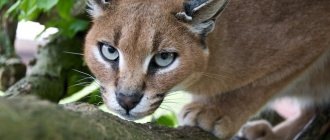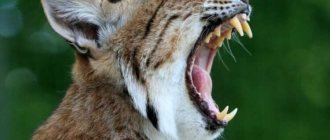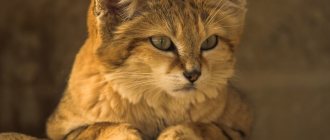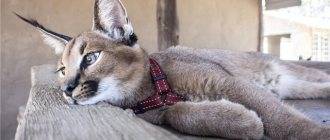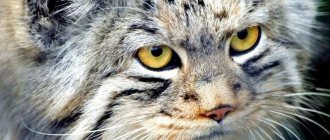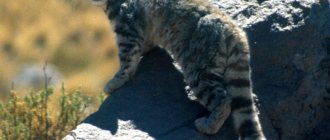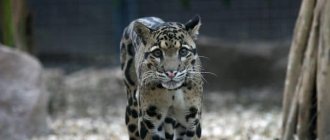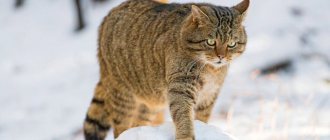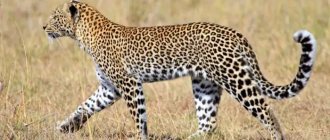The caracal is nothing more than a wild cat with a streamlined, slender body, covered with short hair of a golden-reddish hue, and also with a unique pattern in the muzzle area. The caracal is also called the desert lynx, although the lynx is distinguished by shorter limbs, as well as the presence of a peculiar pattern on the coat, in the form of stripes and spots.
These are the fastest and also the largest wild cats on the African continent. Before modern caracals acquired that appearance and that anatomical structure of the body, about 4 tens of millions of years passed.
Description and origin of the species
The name "caracal" was proposed by the French naturalist Georges Buffon in 1761, and comes from the Turkish "kara-kulak", which literally translates to "cat with black ears". The Greeks and Romans called the caracal a lynx, but today the name "lynx" belongs to a different genus. However, the animal is still often called a lynx.
The first scientific description of the species was made by the German naturalist Johann von Schreber in 1776 from the skin of an animal from the Cape of Good Hope. The animal received the scientific name Felis caracal. In 1846, British zoologist John Edward Gray separated the predator into a separate genus, Caracal, and changed the scientific name of the species to Caracal caracal. The animal belongs to the Feline family and the subfamily Small cats (Felinae).
Genetically, the caracal's closest relative is the African golden cat, another member of the Caracal genus. Their common ancestor separated from the common genetic line with the serval about 2 million years ago.
Owner reviews
According to experienced steppe lynx breeders, a private country house with an attached special enclosure is best suited for keeping a wild cat. The standard area of such an enclosure should be at least 15-16 m2. The room needs to be equipped with special steps, shelves for jumping, as well as a scratching post in the form of a log or wooden block covered with hemp twine.
Important! Raising a domestic caracal should begin from early childhood. In its behavior during play, the steppe lynx resembles a dog. Even small caracals love to run after different objects and bring them to their owner.
For games, it is recommended to purchase durable and reliable toys made from natural and durable materials . The animal easily gets used to the leash and collar, caresses and purrs like an ordinary domestic cat. If necessary, the steppe lynx gets used to using a toilet in the form of a tray well and quickly.
The domestic caracal is very vindictive and remembers rude treatment or physical punishment well. In retaliation, the animal may scratch or bite the owner, as well as ruin all the furniture in the house. If you do not have confidence in your own abilities, then it is recommended to involve professionals for training, who will instill in the wild cat the full range of necessary skills and quickly socialize the animal.
An amazingly beautiful animal, a predator from the cat family, the steppe lynx - Caracal. For a long time, the caracal was considered a type of lynx, as there are some external similarities. But due to a certain set of genetic differences, this cat began to be considered as a completely separate species.
What does a caracal look like?
The caracal is a medium-sized wild cat. It is distinguished by an elongated muscular body, strong build, short muzzle, long powerful legs, and ears with black tassels. The height of the animal at the withers reaches 40-50 cm. The body length of males is on average 78-108 cm, plus a tail 21-34 cm long. Females are inferior in size to males: body length with head varies from 71 to 102 cm, with a tail 18 cm long. -31 cm. Males weigh from 7.2 to 19 kg, females are slightly smaller - from 7 to 15.9 kg.
On the ears of the caracal, recognizable black tassels up to 4.5 cm long are visible. With age, when the animal ages, the tassels may drop down. The animal has a narrow eye shape. Lowering the upper eyelid slightly helps protect the eyes from bright sunlight. On the muzzle there are black stripes from the corners of the eyes along the nose to the mouth, 3 dark stripes also cross the forehead and there are small specks of white fur near the eyes and mouth of the animal.
The caracal has no spots on its skin, the color is uniform and varies from red to reddish. The fur on the belly and back of the limbs is noticeably lighter. Very rarely, but there are black caracals - melanistic animals. The short and dense coat becomes coarser in summer and softer in winter due to the longer and denser undercoat in winter. In winter, the coat is longer - the length of the guard hair is about 3 cm in winter, and shortens to 2 cm in summer.
Norwegian Forest Cat
The animals, very similar to the lynx, are of Scandinavian origin, but at the same time they are very energetic and active. Pets are intelligent, smart and love to play with children.
- As an inheritance from its ancestors, the cat received long thick hair and a fur collar around its neck.
- The animals boast their flexible and strong bodies, long legs and bushy tails.
- Their ears, pointed at the tips, have tufts like those of a lynx.
- The cat's head is shaped like a triangle.
- The animal's eyes are oval, large, and wide open. Their color is in harmony with the color of the coat.
The Norwegian Forest can have any color except cinnamon and chocolate.
Care and nutrition
These cats do not require special grooming.
- During shedding in the fall and spring, their coat needs to be brushed every day.
- Nails should be trimmed several times a month.
- It is recommended to clean your pet's ears with a cotton swab once every two weeks.
- You can feed your animals with super premium dry food or natural food, excluding pork, salted and smoked products.
Norwegian Forest Cats are playful and brave pets.
Those who, even in a big city, want to feel constant contact with wild nature, can get an animal similar to a lynx. They are active, playful and can become a family member and good friend.
Caracal and lynx
The caracal is often confused with the lynx. Outwardly, these animals are similar, both have a strong muscular body and pointed ears with tassels. The caracal is slightly smaller in size than the lynx, plus there is a difference in color - the lynx has grayish fur with dark spots, while the caracal has a uniform color without spots or stripes.
Caraquet
Since the wild cat caracal, whose price reaches tens of thousands of dollars, is distinguished by its unbridled disposition and tough character, breeders decided to cross it with a domestic Abyssinian cat. The first hybrid of the F1 generation appeared in the world in 2007 and was named Caraket.
Caraquet kittens are very similar to their wild counterparts - they have a beautiful face, black ears and a beautiful coat color.
Caraqueta has a slender, muscular body. Its weight is about 12 kilograms, and its body length is about half a meter. The kitten's athletic body structure allows it to make high jumps, and the inherited caracal genes gave it good hearing, health, endurance and a well-developed digestive system adapted to digest heavy food. But participation in the domestic cat breeding program also gave its sign - Caracas have a gentle disposition, friendliness and energy.
This breed is very rare and expensive. For a successful mating outcome, breeders must adhere to a number of conditions, and even if the mating, pregnancy and birth go well, one or two kittens are born. In this case, the males remain sterile until the fourth generation. Therefore, the price of caracal is about 15 thousand rubles. dollars (kittens are sold without breeding rights) is considered a difficult breed. So far, the sale of Caraquet kittens is in the pre-sale preparation stage.
At the moment, breeding work is underway, as the breeders have not yet achieved their goal. They strive to breed a breed whose representatives will be characterized by the following features:
- plain color without stripes or rosettes;
- tassels on ears;
- meek disposition.
The difference between a caracal and a serval and a puma
In color, the caracal resembles a puma - the same uniform red or reddish coat color with lighter fur below. In terms of physique, the caracal is very similar to the African golden cat, but it has darker fur and no ear tufts.
Besides the African golden cat, the other close relative of the caracal is the serval. The serval differs from the caracal in its spotted color, larger ears without tufts, and much longer limbs and tail.
American Bobtail
This is a relatively new breed that appeared in the States in the 60s of the 20th century. From childhood, kittens look like little lynxes: they are born with short tails and fluffy wings on their cheeks. The spotted or striped color gives it an additional resemblance to a lynx. The American Bobtail has hind legs that are slightly longer than the front legs, like a lynx. Therefore, even the gait resembles a trot. Despite all this, the American Bobtail is a very gentle and domestic creature.
Peculiarities:
- Height up to 30 cm, weight up to 6 kg;
- Quickly find a common language with people, cats, dogs;
- They become attached to a person;
- They tolerate moving well and adapt quickly;
- Price from 10,000 rub.
American Bobtail
Where does he live?
Most of the caracal population lives in Africa. Predators are widespread south of the Sahara, but are practically absent in the north. In Asia, the animal lives on the Arabian Peninsula (Jordan, Saudi Arabia, Oman, Yemen), the Middle East (Israel, Turkey, Libya, Syria), Central Asia (Iran, Turkmenistan, Uzbekistan, Kazakhstan, Tajikistan, Pakistan), and northwest India.
The caracal prefers to live in arid areas with low precipitation and natural shelters - stones, thickets, grass. The predator lives in forests and bushes, savanna and prairies, inhabits deserts, semi-deserts and swampy lowlands. Caracals are perfectly adapted for steppe arid terrain with a minimal amount of greenery.
In Ethiopia, the cat is often seen along the roads, and the animal is hit by cars. A caracal was spotted in Abu Dhabi in 2021 for the first time since 1984. In Uzbekistan, the animal lives only in the Ustyurt and Kyzylkum deserts. In India, the predator is found only in the Sariska and Ranthambore national parks in the Rajasthan province in northern India.
What does it eat?
Caracals are carnivorous carnivores, feeding mainly on small mammals, rodents and birds. In South Africa, the caracal's diet consists of the following animals:
- cape grisbok
- bush duiker
- bush rat
- cape hyrax
- hares
- birds
- sheep
- goats
Mammals typically make up about 80% of an animal's diet. From time to time, predators also eat snakes, lizards and insects. In western India, caracals eat mainly rodents. On occasion, the caracal also hunts larger antelopes - kudu, impala, springbok, Cape bushbuck, mountain swamp goat.
The caracal is a fast and powerful predator, so it even hunts prey that is 2-3 times its size. Powerful hind legs allow the animal to jump to a height of 3 meters and catch birds in flight. The caracal has excellent coordination, and is able to turn while jumping and change the direction of its body in the air. Excellent at climbing trees.
The predator's favorite method of hunting is to sneak up to the prey at a distance of 5-6 meters, then overtake the prey in several jumps. The caracal kills small animals with a bite to the back of the head; large antelopes are usually strangled by clinging to the neck. After a successful hunt, the predator eats the prey immediately, less often drags the victim into a tree or drags it to a secluded place. The caracal hides the remains of large prey for later, so that it can return and finish eating in the future. On occasion it feeds on carrion, but quite rarely.
Text Analysis.docx – Text Analysis
Analysis of the text Caracal 1. desert - these are its habitats. 3. Steppe lynx, or caracal, inhabitant of the plains. 2. Savannah, steppe. Only at short distances does the steppe lynx develop speed sufficient to catch the fastest prey. 4. First he crawls as close as possible, then a few jumps - and the prey is captured. 5. The jumps are considerable - almost five meters. 6. For a relatively small animal (its length is 60 - 80 centimeters) this is excellent jumping ability. 7. In summer, caracals hunt at night, and in winter, spring - and in the light of the sun. 8. Shelters where they hide during the day, holes of porcupines, foxes or dense bushes, a crevice in the rock. (I. Akimushkin.) Working with text 1. Make two types of plan: Simple plan Complex plan 2. Characterize the caracal through keywords (association method). Karakal 3. 4. 5. Determine the style of the text by constructing a detailed answer. Explain the placement of dashes in sentences in the text. Explain why a comma is placed before the conjunction OR in the first sentence, but not in the 8th sentence. 6. Explain the connection of punctuation marks - comma, dash - in the last sentence.
Character and lifestyle
Caracals are primarily nocturnal, although they can be somewhat active during the day. At low temperatures, animals are more active; in the heat they prefer to lie down and wait it out. The caracal, like other wild cats, is a solitary animal. Adult caracals meet each other only during the mating period. The only exception is females with growing cubs.
Adults live in their own territory. Caracals mark their areas with claw marks and excrement, and also urinate on vegetation and rocks. The size of a male's territory averages about 220 square kilometers, while that of a female is approximately 57 square kilometers.
The size of the territory depends on the terrain, animal population density and food supply. In Saudi Arabia, male territories reach an area of 1,116 square kilometers, while female territories in South Africa's Mountain Zebra National Park are only 4 to 6.5 square kilometers. The hunting grounds of predators can overlap greatly.
Caracals are excellent tree climbers. Predators often communicate with each other using ear tufts. Animals shake their heads or move their ears to signal to their relatives. Like other wild cats, caracals can make a wide range of sounds - hissing, growling, snorting and purring.
Spread range
Geographical distribution
The caracal has a very wide distribution, one of the most extensive of living carnivores, from the southern tip of the African continent, north to the Arabian Peninsula, the Middle East and Turkey, east to central India and further north to Kazakhstan and Turkmenistan.
Photo: Wikipedia
Its historical range has shrunk only on the periphery, where the caracal has suffered significant losses. In North and West Africa in particular, the caracal was exterminated en masse in areas with high rates of livestock land conversion. Experts estimate that it has lost 37.7% of its historical distribution . However, the steppe lynx is most common in South Africa and Namibia, where its range is expanding, possibly due to the extermination by farmers of the black-backed jackal, an enemy of the caracal. In Asia, these felines remain unevenly distributed and are limited to harsh winters, when the Himalayas act as a natural barrier preventing the predator from spreading further north.
Habitat
The caracal occupies a wide variety of landscapes and habitat types at altitudes ranging from sea level to 3,300 meters . However, preference is given to areas at an altitude of less than 1200 meters.
The steppe lynx can be found in arid forests, savannas, scrubland, hilly steppes, arid mountain ranges and on the edges of large sandy areas. Particularly in arid or semi-arid areas, it is most often found in dense vegetation on rocky slopes and in riparian habitats where rodent populations are high.
Photo: Justin Hawthorne
The caracal uses vegetation for cover when hunting and trees for shelter. It sticks to open areas during nocturnal activity and prefers denser thickets and rock crevices during the day. Vegetation offers the predator valuable shade while resting on hot days.
On the African continent, steppe lynxes generally avoid equatorial rainforests and open sandy deserts . In the Asian region, the caracal prefers the drier regions of India, Central and South-West Asia.
Home range
Overall population density depends on prey availability, habitat type, and degree of human persecution. Research shows that the drier the landscape, the fewer individuals it supports. In the semi-arid habitats of Western India there are about 4-5 individuals per 100 sq. km. Throughout South Africa, densities are estimated at 23-47 individuals per 100 sq. km. But in the Beydaglari Mountains in Turkey, only 1.7 individuals per 100 square meters live. km.
Photo: kinou66
Males have a larger home range , partially overlapping the territories of several females. In a well-watered coastal protected area in South Africa, radiotelemetry studies have shown home ranges of adult males to be 31-65 sq. km, and females – 4–31 sq. km.
Reproductive status also influences home range size. When raising cubs, the habitats of females are reduced by an average of 2-2.5 times.
Reproduction and young
Both females and males reach sexual maturity by 1 year. However, successful mating occurs a little later, when the animals reach 12-15 months. The mating season lasts all year round. Females go into estrus for 1-3 days, and continue every 2 weeks until the female becomes pregnant. During the period of estrus, the female attracts males with urine marks, then, upon seeing the male, the female lies down on the ground. During the mating period, animals form temporary pairs, but immediately after mating these unions disintegrate.
The female's pregnancy lasts from 2 to 3 months. In a litter, from 1 to 6 kittens are born. Peak birth rates occur between October and February. Females give birth in cover of dense vegetation, or in abandoned aardvark or porcupine dens. Moreover, even before the birth of the cubs, the female prepares several shelters in order to drag the kittens in the future from place to place.
Caracal kittens are born blind, with drooping ears and, unlike adults, cannot retract their claws. The color of a kitten is similar to the color of an adult animal, differing only in the spots on the abdomen of the cubs. The eyes open on the 10th day, and at first the kittens have blue eyes. By 3-4 weeks, kittens learn to retract their claws and their ears become erect. At this time, the cubs actively explore the den, and the female has to change the location of the shelter almost every day.
From 1.5 months, the cubs begin to eat meat and actively play with each other. At 3 months, kittens already go hunting. Milk teeth grow in 50 days, molars by 10 months. At 9-10 months, young caracals gradually leave their mother, although young females stay with their mother longer.
Communication
three of these perceptual systems to communicate . It is assumed that the position of the ears is used for intraspecific communication.
When threatened, the caracal slowly approaches the enemy, holding its head below shoulder level, ears turned outward, and tail twitching. At a higher threat level, it holds its mouth open with teeth exposed and ears pinned back, hissing or spitting.
The caracal is known to exhibit a range of vocalizations, including purrs, growls, hisses and meows. Zoologists additionally mention a leopard-like cry that adults sometimes make. Young kittens emit a high-pitched cry, reminiscent of the cry of a Cape sparrow.
Steppe lynxes also interact through urine spraying and scent marking. They have buccal, mental and anal scent glands that allow individuals to mark territories and demonstrate their receptivity.
Natural enemies
Caracals avoid larger cats - lions, cheetahs, leopards, and also stay away from packs of hyenas and wild dogs. Thanks to their red color, caracals are perfectly camouflaged in steppe and desert areas, simply lying down on the ground. The animal is distinguished by its agility, which helps it escape from pursuit.
The predator's main competitors for prey are foxes, wolves, leopards, and hyenas. Leopards are especially dangerous for caracals in the wild. These predators not only take prey from the animal, but also actively hunt the caracal itself. The caracal has little chance against a leopard.
Humans pose a greater threat to the animal.
- reductions in habitat and food supply are reducing populations worldwide;
- in Africa, farmers actively shoot predators to protect small livestock;
- in Uzbekistan, caracals are killed by shepherds to save sheep and goats;
- in Turkey, Iran and Ethiopia, the animal often gets run over on the highway;
- in the Arabian Peninsula, animals are often hunted for their skins.
Did you know?
- The average lifespan of a caracal in the wild is 10 years, but captive specimens can live up to 19 years.
- The caracal was traditionally used as a hunting cat by the royalty of Iran, India, Egypt and Syria. Tamed predators hunted antelope, rabbits, peacocks and pheasants.
- The ancient Egyptians attached a certain religious significance to these felines, mummifying them to guard their tombs.
- The caracal usually does well in captivity. However, its natural instincts, including hunting, high jumping and marking, make it an undesirable pet with high demands on personal space.
- In 1998, a caracat, a hybrid of a caracal and a domestic cat, was born for the first time at the Moscow Zoo.
Population and protection of the species
The caracal has been listed as a species of least concern on the Red Book since 2002. Since the animal lives in 50 countries, the status of the population in different regions varies greatly. In North Africa, the predator has now been practically exterminated. In Pakistan, Jordan, Kazakhstan and Uzbekistan, the population is on the verge of complete extinction. A stable population has survived only in southern and central Africa.
Today, caracal hunting is prohibited in the following countries:
- Afghanistan
- Algeria
- Egypt
- Tunisia
- Israel
- India
- Iran
- Pakistan
- Syria
- Tajikistan
- Türkiye
- Turkmenistan
- Morocco
- Kazakhstan
- Libya
- Jordan
Save Status
The caracal is listed as "Least Concern" , despite population trends being unknown across much of the steppe lynx's geographic range. They are considered rare or endangered only in Asia and North Africa, and are considered nearly extinct in India.
Although the caracal is protected by law in many countries, its populations are threatened by widespread habitat destruction for agricultural development or road construction, poaching for fur or meat, the trade in exotic animals, and conflicts with farmers.
Domestic caracal
Caracals are easily tamed and were popular pets in ancient times in Egypt, Asia, India and other countries. Now the fashion for caracals as pets is gradually returning. This cat breed is not cheap - the price of a purebred kitten from a nursery in Russia is about 0.5 million rubles. A kitten of the Caraquet breed, a hybrid of a Caracal with a domestic cat, will cost less - from 100,000, depending on the generation and pedigree.
Keeping a caracal at home will require effort. The animal needs a personal living space of at least 15 square meters. You will have to give the cat a separate room or build a large enclosure with a run. The room or enclosure must be at least 2.5 meters high. Inside you need to make shelves and arrange the branches at different heights so that the predator can climb to its pleasure.
Cats easily learn to use the litter box, but they do not bury themselves, so you will need to clean up after the animal regularly. You will definitely need a scratching post, otherwise you will have to regularly trim your nails at the veterinarian. Like other pets, a cat needs to be vaccinated and possibly neutered. It is better to take the animal to the veterinarian for procedures. Given the size of the cat, a steady hand will be needed.
By nature, domestic caracals are very active and energetic cats; they love to play and get along with cats and dogs relatively easily. The animal should be fed food close to its natural diet:
- meat, and unpeeled (with feathers, entrails, wool, bones);
- sea fish
- eggs
- pureed vegetables (a little) - pumpkin, zucchini, carrots, cabbage
A caracal eats approximately 300-800 grams of food per day. You won't be able to feed him ready-made food.
While admiring the grace, power and beauty of the animal, we should not forget that the caracal is still a predator by nature. Do not leave your cat alone with small children, poultry or rodents. An animal needs to be raised and trained from an early age, and given a lot of attention. If you don’t do this, you may find yourself locked in one house with a beautiful and powerful, but wild cat.
Dash between clauses
Dash between subject and predicate
1. noun –
2. undefined form ch. – undefined Ch. Form
3.number – number.
4. noun – ↔ undef. Ch. Form
Note:
A dash is placed ONLY when there is a logical emphasis on the subject or predicate
1) personal pronoun - noun
2) noun – not+ noun.
The most beautiful thing in the world is a mother's eyes
Five and six are eleven
Talking too much will only harm the cause
The road going through the forest is the shortest distance to the station
Class is your bazaar (compared to Union)
A drop of honey is like a pearl
Heart stone
Learning does not mean imitating something
The steppe lynx, or caracal, is a resident of the plains
A dash is placed
1) between two homogeneous members of a sentence, not connected by conjunctions, to express sharpness, opposition
Nr: They don’t live here – it’s paradise
2) before the conjunction And, connecting two homogeneous predicates, if the second of them contains a consequence of what is indicated in the first predicate, or expresses a sharp opposition, or communicates something unexpected
Example: The army invaded - and at six o’clock in the afternoon I saw the enemy among the vast field of Kulikov
Note: to enhance the connotation of surprise, a dash can be placed after the conjunction I.
Example: asking for payment on Saturday and marching to the village
Dash between subject and predicate.
1. A dash is placed between the subject and the predicate:
with a zero connective (i.e. in the absence of a linking verb), while the subjects and predicate are expressed by a noun or a cardinal numeral in the nominative case, an infinitive. (My mother is a teacher.)
if the predicate is preceded by the words this, that means it means (Defending the Motherland is our duty.)
2. There is no dash between the subject and the predicate:
if comparative conjunctions are used as a connective: as if, as if, exactly, like, etc. (This house is like a block.),
if the subject is expressed by a personal pronoun (the dash in this case is considered as the author's) (She is a ballerina.),
if the predicate is preceded by a negative particle not (Poverty is not a vice.),
if the predicate is preceded by a secondary member of the sentence that is not consistent with it (Plato is my friend, but the truth is more precious.),
if between the main members of the sentence there is an introductory word, adverb or particle (Ivan is also a student. His father, apparently, is an engineer.),
in conversational style sentences (His brother is a student.).
A dash in an incomplete sentence.
A dash is placed in an incomplete sentence if a predicate (most often) or some other part of the sentence is missing, but it can be easily restored from the context or from the situation (She went home, he went to the cinema),
If for a sentence the absence of a predicate is the norm, then a dash is not placed (the predicate is implied and can be easily guessed from the content of the sentence itself): Again, at the hour of a night cloud above the ground.
Intonation dash.
1. An intonation dash is placed at the point where a sentence breaks down into word groups in order to emphasize the semantic relationships between the members of the sentence and help the reader correctly connect words according to meaning (Children need to explain.)
Connecting dash.
1. A dash is placed:
between words to designate a certain space (train Nikolaev - Moscow), quantity (buy two or three kilograms of sweets) or a period of time (Revolution of 1905-1907), if it replaces the meaning of the construction “from ... to”,
between proper names, the totality of which is some name (of a teaching, scientific institution, etc.): the Boyle-Mariotte law, the match “CSKA - Lokomotiv”.
Separating definitions and applications
Definitions
Separated:
1. With dependent words coming after the word being defined
I stood alone on an icy platform, lost among the steppes of Bashkiria.
2. Two or more after the word being defined
Through the juniper, gnarled and unkempt, a luxurious, beautiful lungwort sprouted and blossomed in the light.
3. Related to a personal pronoun
He stands, pale, in the middle of the highway.
4. Standing before a defined noun and having an additional adverbial meaning
Deafened by the heavy roar, Terkin bowed his head.
5. Separated from the defined noun by other members of the sentence
Not separated:
1. With dependent words standing before the word being defined, if they do not have additional adverbial shades of meaning
The sparrow flew under the dome of the hall, sat down on the chandelier and began to clean the feathers disheveled in the fight.
2.If in meaning they are connected not only with the subject, but also with the predicate and are part of it.
Marya Ivanovna came to dinner pale and tear-stained.
3. With dependent words after the indefinite pronoun
From the darkness of the branches something terrible, dark and cold looked at those walking.
4. Expressed by a participial with dependent words, if they relate to a defining, demonstrative and possessive pronoun.
Applications
1) If the application refers to a common noun, then it is isolated in any case, regardless of its place in the sentence. For example:
My father, captain of the border troops, served in the Far East and Captain of the border troops, my father served in the Far East.
2) If the application refers to a proper noun, it is isolated only when it comes after it. For example:
Ivanov, captain of the border troops, served in the Far East and Captain of the border troops Ivanov served in the Far East.
3) If the application refers to a personal pronoun, then it is isolated in any case, regardless of its place in the sentence. For example:
He, captain of the border troops, served in the Far East and captain of the border troops, he served in the Far East.
This rule has a few notes:
1. Sometimes an application that is given great importance in a statement and which stands at the end of a sentence can be separated with a dash rather than a comma, for example: August was coming to an end - the last month of summer.
2. Sometimes an application may begin with the conjunction HOW. In such cases, you should try to replace this union with the combination IN QUALITY. If such a replacement is possible, then there is no need to put commas. For example: Gas as a fuel is now used very widely. The rules for placing commas before the conjunction HOW will be discussed in more detail in a separate part of our course.
